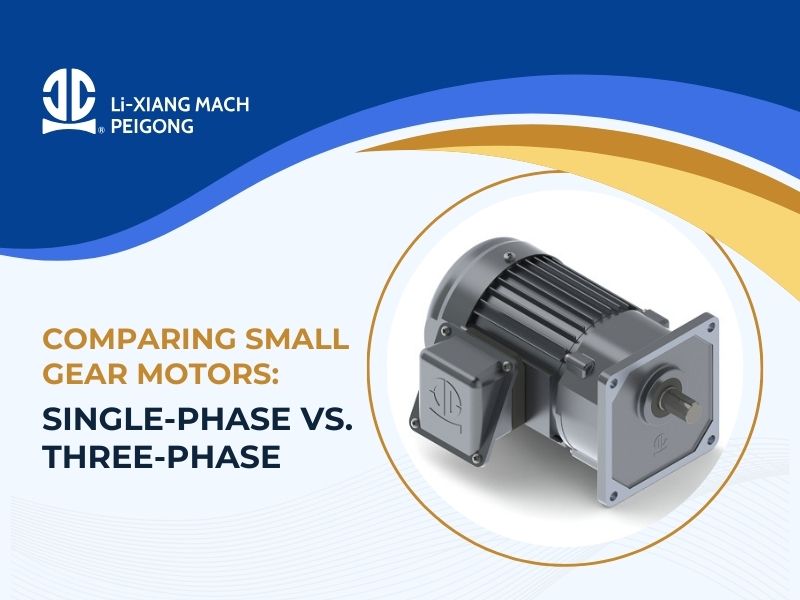SEARCH
Comparing Small Gear Motors: Single-Phase vs. Three-Phase
Introduction
Small gear motors are essential components in industrial, commercial, and residential applications, offering efficient power transmission in a compact size. One of the key considerations when choosing a small gear motor is whether to use a single-phase or three-phase motor. Each has its own advantages and is suited for different applications.
As a leading manufacturer, PEIGONG provides high-quality small gear motors tailored to meet diverse industry needs. In this article, we compare single-phase vs. three-phase small gear motors, highlighting their differences, benefits, and best-use scenarios to help you make an informed decision.
1. Understanding Single-Phase Small Gear Motors
A single-phase small gear motor runs on 110V or 220V AC, commonly found in homes and small businesses. These motors are simple, cost-effective, and suitable for light-duty applications.
Advantages:
- Affordable & Easy to Use – Simple design makes them low-cost and easy to install.
- Works with Standard Power Supply – Compatible with household and commercial electricity.
- Compact & Lightweight – Ideal for small conveyors, pumps, and appliances.
Disadvantages:
- Lower Efficiency – Uses more power compared to three-phase motors.
- Limited Power Output – Best for applications under 3 HP.
- More Heat Generation – Can overheat with prolonged use.
2. Understanding Three-Phase Small Gear Motors
A three-phase small gear motor operates on 220V, 380V, or higher AC power, offering higher efficiency and performance. These motors are common in industrial settings where continuous, high-power operation is required.
Advantages:
- Energy Efficient – Converts power more efficiently, reducing long-term costs.
- Higher Torque & Power – Handles heavy loads and continuous operation.
- Smooth & Stable Performance – Less vibration, reducing wear and extending motor life.
Disadvantages:
- Requires Three-Phase Power Supply – Not suitable for areas without industrial power access.
- Higher Initial Cost – More expensive than single-phase motors.
- Complex Installation – Requires professional setup.
3. Key Differences Between Single-Phase and Three-Phase Small Gear Motors
| Feature | Single-Phase Small Gear Motor | Three-Phase Small Gear Motor |
| Power Supply | 110V or 220V AC | 220V, 380V, or higher AC |
| Efficiency | Lower efficiency, higher power use | Higher efficiency, lower energy loss |
| Torque Output | Lower torque, limited power | Higher torque, suitable for heavy loads |
| Performance Stability | May vibrate, less stable | Smooth operation, minimal vibration |
| Best Applications | Home appliances, small machinery | Industrial automation, conveyor systems, pumps |
| Heat Generation | More heat, requires cooling | Better heat dissipation, runs cooler |
| Installation & Cost | Easier to install, lower cost | Higher cost, complex installation |
4. Choosing the Right Small Gear Motor for Your Application
Selecting the right small gear motor depends on several factors:
Available Power Supply
- If your facility only has access to single-phase power, a single-phase gear motor is the practical choice.
- If three-phase power is available, a three-phase motor will deliver better efficiency and performance.
Load & Torque Requirements
- Light-duty applications (e.g., vending machines, small pumps, fans) → Single-phase motor.
- Heavy-duty applications (e.g., industrial automation, large conveyor belts) → Three-phase motor.
Energy Efficiency & Long-Term Cost
- If energy savings are a priority, three-phase motors are more cost-effective over time due to higher efficiency.
Budget & Maintenance Needs
- Single-phase motors are cheaper upfront and easier to install, but may require more maintenance.
- Three-phase motors are more expensive initially, but require less maintenance and have a longer lifespan.
5. Common Applications of Small Gear Motors
Single-Phase Small Gear Motor Applications:
- Home appliances (washing machines, fans, air conditioners)
- Small conveyors and light-duty packaging machines
- Medical devices and office equipment
- Small water pumps
Three-Phase Small Gear Motor Applications:
- Industrial automation and robotic systems
- Large conveyors, hoists, and cranes
- Injection molding machines and CNC machinery
- High-power ventilation and industrial pumps
Conclusion
Both single-phase and three-phase small gear motors have unique advantages. Single-phase motors are cost-effective, easy to install, and suitable for light-duty applications, while three-phase motors offer higher efficiency, better performance, and long-term durability for industrial use.
At PEIGONG, we provide high-quality small gear motors for both single-phase and three-phase applications, ensuring reliable performance for various industries. Whether you need energy-efficient motors for automation or compact solutions for small-scale operations, our products are designed for maximum efficiency and durability.
Need help choosing the right small gear motor? Contact PEIGONG today and let our experts help you find the best solution for your application.


